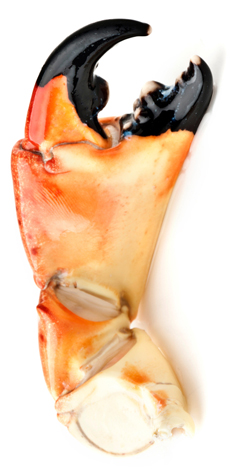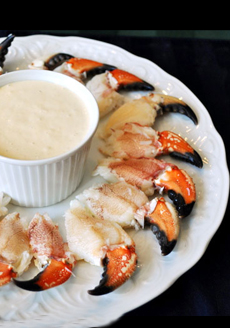TIP OF THE DAY: Stone Crab
|
Our friends at the Grand Central Oyster Bar in New York City remind us that stone crab is now in season. Florida stone crabs are legal for harvest from October 15th through May 15th. Frozen stone crab is available year-round, but the true palate pleaser is the fresh crab.
The stone crab (Menippe mercenaria), also known as the Florida stone crab, lives in the western North Atlantic, from Connecticut down to Belize; and the Caribbean, including the Bahamas, Cuba and the Gulf of Mexico. The stone crab is a cousin of the Maryland blue crab (Callinectes sapidus, also known as the blue crab, Atlantic blue crab or Chesapeake blue crab) and the Gulf stone crab (Menippe adina), a closely related species. It tastes like a cross between the blue crab and the Maine lobster—less definitive than lobster but more so than crab. The body is relatively small without much meat; the part that is eaten is the big, meaty claw, which is very distinctive in appearance with black tips. When harvesting, one or both claws are removed on the boat and the live crab is returning to the ocean, where it will regenerate its claws. Sustainability-oriented fishermen remove only one claw, so the crab can protect itself while the other regenerates. The Monterey Bay Aquarium’s Seafood Watch has given the Florida stone crab industry its highest rating of “Best Choice,” for maintaining high fishing standards and working hard to keep the stone crab population viable. The claws are strong enough to break an oyster’s shell—like us, stone crabs love to eat oysters. Claws are sold by size, generally in four sizes: medium, large, jumbo, and colossal. |

A stone crab claw. Photo courtesy Fruge Seafood. |
|
|
RECIPE: STONE CRAB CLAWS The easiest way to serve stone crab claws is to boil them, and serve them hot or chilled with melted butter or other sauce (the two most popular are mustard sauce and remoulade sauce). What looks like a very impressive dish couldn’t be easier to make. The difficult part comes when the diners have to extract the meat from the shell—you may have heard of the “Maryland crab bash,” where diners get a bib and a hammer. Or, you can remove the shells yourself, prior to serving (instructions are below). Note that there is a hard center membrane inside the meat, so take care if biting into what looks like a large lump of meat. It’s better to pull the meat off with a fork. |
||
|
|
Ingredients
|
|
|
Preparation 1. BRING a pot of 12 cups of water, plus a teaspoon of salt, to a rapid boil; remove from the heat. When the water stops bubbling, place the crab claws in the water for about five minutes. Do not submerge the claws into the rapidly boiling water, as they can toughen. 2. DRAIN the crab claws into a colander (warning: the claws and water will be very hot) and rinse under cold water to make them easier to handle. 3. PREPARE the dip. The easiest is to combining 4 tablespoons of butter with minced garlic and salt or other seasoning of choice (for example, Old Bay Seasoning). Microwave butter mixture until melted, about 90 seconds (time will vary by microwave). 4. SERVE with melted butter and wedges of lemon. 1. PLACE the claw on a cutting board or other hard surface. Then, place a plastic bag over the claw to prevent the juices from splattering. 2. USE a mallet or hammer (cleaned, of course!) and lightly crack the claw in the first and second knuckles; then crack slightly harder in the center of the claw. 3. PEEL the shell from the claw and then separate the two knuckles from the main pincher. Serve with sauce and citrus wedges. NOTE: Crack only as many as claws as you plan to eat at one meal. Once cracked, the claw meat will not hold up well for a long period of time. |
||



